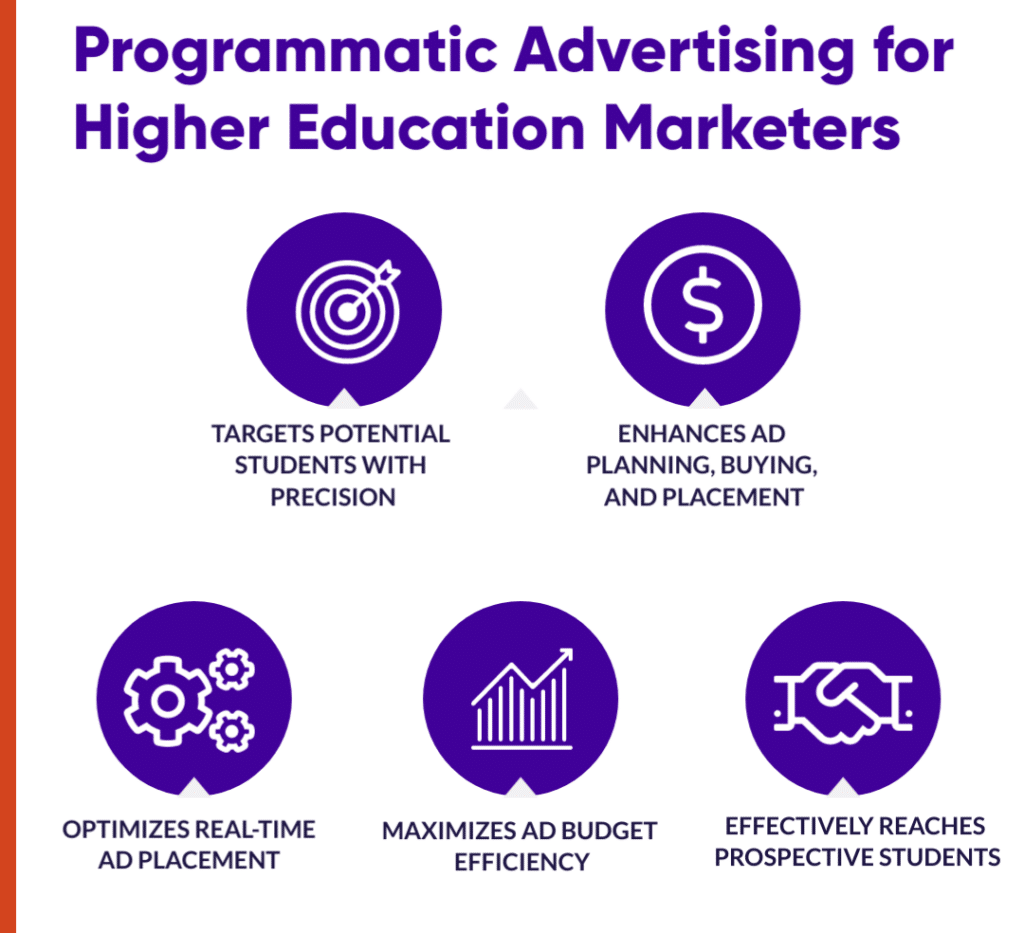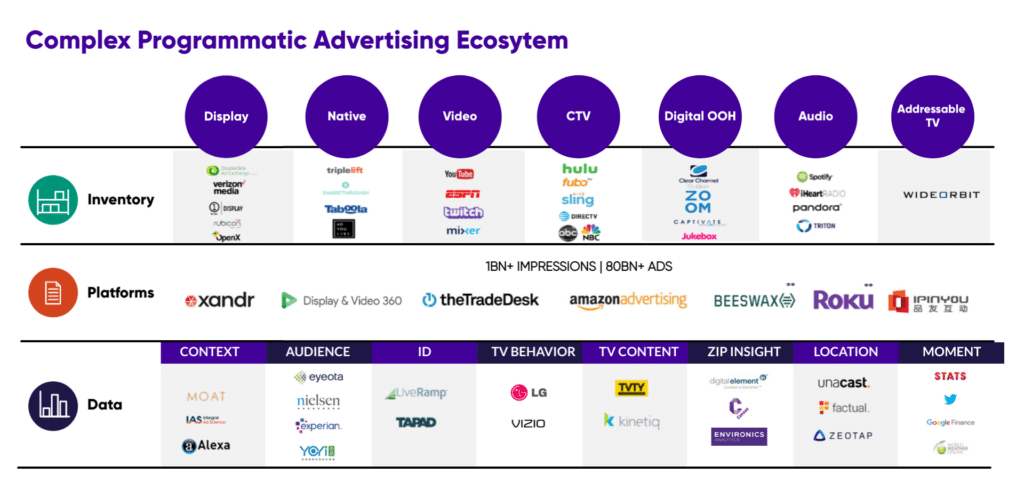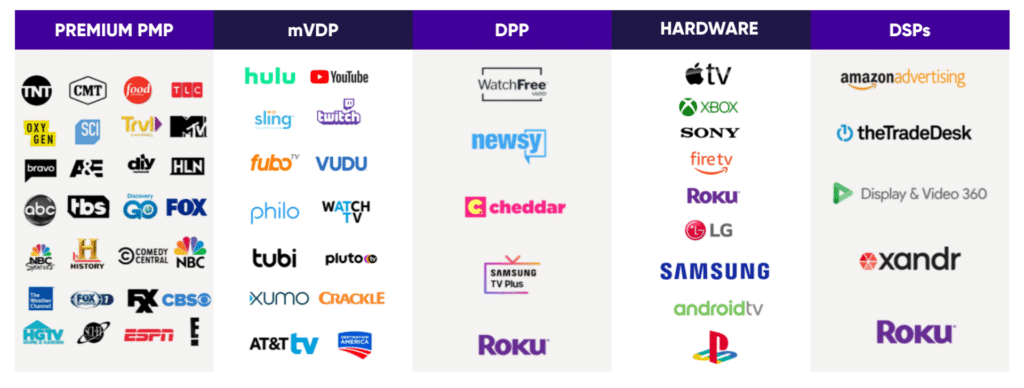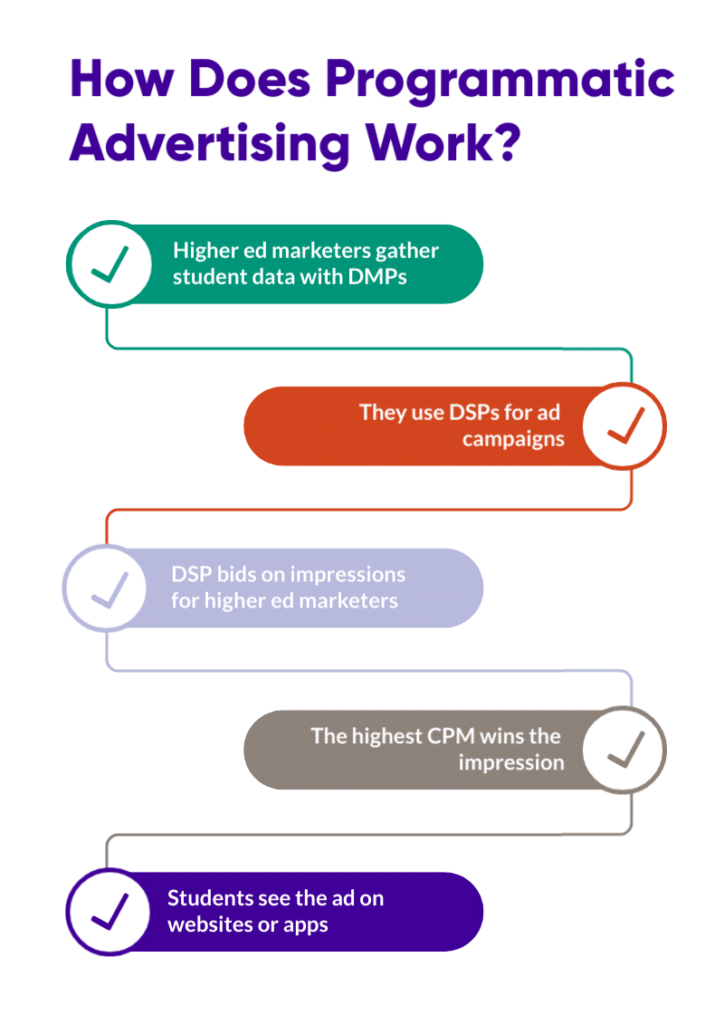Everything You Need to Know About Programmatic Advertising in Higher Ed

Programmatic Advertising Essentials for Higher Education Marketers
Over the years, programmatic advertising has grown in popularity, revolutionizing how digital ads are bought and sold. Traditional ad-buying methods are still hanging in there, but they’ve taken a backseat with the rise of digital advertising and programmatic media buying.
Traditional methods rely on a whole lot of guesswork. You don’t have much say in who gets to see your ads, so you might end up wasting them on folks who couldn’t care less about what you’re offering. Like handing out flyers for a vegan joint at a meat lover’s paradise – it’s not the most efficient move.
More and more advertisers are flocking to programmatic advertising because it allows them to precisely target their desired audience, optimize campaigns in real-time, access valuable data and analytics, and automate the buying process for greater efficiency.
Universities and colleges continuously seek innovative and cost-effective ways to stand out and entice students to choose their programs over others. Programmatic advertising is one of the many tools they use to reach, engage, and enroll students.

What is Programmatic Advertising, and What is its impact on Marketers?
In a rapidly changing world, higher education is aligning its programs with the evolving labor market and effectively engaging interested but unenrolled students. Programmatic advertising is crucial in this effort by connecting colleges and universities with potential students through targeted digital campaigns. This innovative approach reshapes outreach strategies, guiding the right students toward enrollment.
Programmatic advertising is a data-driven, automated technology that helps marketers plan, buy, and place digital ads. It involves using software and algorithms to purchase and optimize real-time ad placements.
It also serves as a valuable addition to your higher education marketing media mix, enabling institutions to use it to be smart with their ad budgets and ensure they’re effectively reaching their target audience. Lastly, programmatic advertising operates laser-focused, providing students are more likely to discover the programs and courses that align with their interests and academic goals.
Exploring the Complex Programmatic Advertising Ecosystem
Programmatic advertising is diverse and customizable to achieve specific goals, utilizing digital platforms within a complex ecosystem.
Effective ad placements rely on DSPs, or “Demand-Side Platforms,” as online ad shopping assistants. They gather insights about student interests, enabling colleges and universities to deliver tailored advertisements effectively. However, it’s worth noting that you can’t rely on just one DSP, and the best play here is to have an agnostic approach. Working with multiple DSPs is recommended to improve campaign reach and effectiveness.
Programmatic advertising includes essential components like SSPs, ad exchanges, and DMPs, operating cohesively in an automated manner. Additionally, you’ll encounter elements like mVDP and Premium PMPs that further enrich the process, enhancing its complexity and efficiency.
In contrast to traditional methods, programmatic advertising uses automated software and algorithms to negotiate and make deals, allowing advertisers to purchase ads from thousands of websites simultaneously. This efficiency saves time and effort, reaching many websites without individual negotiations.


How Does Programmatic Advertising Work? A (Very) Simplistic Breakdown
Ads must undergo a series of behind-the-scenes processes before students can see it.
- First, advertisers and marketers start by gathering data about prospective students with the help of DMPs (Data Management Platforms). They collect and analyze data on prospective students, helping create targeted ad campaigns, reach new prospects, and develop detailed student profiles for personalized marketing.
- Afterward, they use DSPs to create campaigns. DSPs connect advertisers to the programmatic system, letting them buy ad impressions from various sources via ad exchanges and header bidding with SSPs.
- The DSP places bids for the advertiser, considering campaign strategies, budget, creative sizes, and various factors when vying for that impression.
- The publisher assigns impressions to the winning bidder, the advertiser/DSP with the highest CPM (cost per one thousand impressions).
- The prospective student sees the ad on the publisher’s website, app, video, or social media.
Programmatic advertising is undoubtedly complex and may have a steep learning curve, but it offers numerous benefits to higher education institutions. It’s about maximizing advertising efforts. This approach equips institutions to shape a positive brand image and fine-tune marketing strategies for enrollment growth and enhanced brand awareness.

What Are the Benefits of Using Programming Advertising?
Programmatic advertising offers some fantastic benefits for higher education institutions. It’s not just about saving money; it’s about making the most of your advertising efforts, reaching the right people, and growing your student enrollment and brand recognition. It also offers higher education institutions the tools to create a positive brand image and optimize their marketing efforts for enrollment growth and brand awareness.
Programmatic advertising can be a highly effective strategy for growing enrollment and building brand awareness for colleges and universities. Here are some ways it can have a positive impact:
- Precise Targeting: Programmatic advertising allows higher education institutions to precisely reach students actively seeking educational opportunities and likely to be interested in their programs.
- Efficiency: Higher education institutions can enhance efficiency through programmatic advertising, which provides targeted advertising, personalization, real-time optimization, cost savings, and social media advertising. These benefits assist in optimizing student recruitment, reaching new prospects, and creating personalized student profiles for marketing..
- Customized Messaging: Institutions can craft messages that speak directly to the needs and interests of prospective students, making their programs more appealing.
- Real-Time Optimization: You can optimize ad campaigns in real time. Make prompt adjustments if a message or ad format is not working as expected. You are ensuring that marketing efforts remain effective and adaptable to changing conditions.
- Brand Awareness: Programmatic advertising is crucial in awareness marketing for educational institutions. They can reach a broader audience by displaying ads on various platforms and websites. Consistent and engaging ad campaigns can leave a lasting impression on potential students.
- Retargeting: Programmatic advertising is crucial in awareness marketing for educational institutions. They can reach a broader audience by displaying ads on various platforms and websites. Consistent and engaging ad campaigns can leave a lasting impression on potential students.
- Better User Experience: It delivers more relevant, less intrusive, personalized ads.
- Measurable Results: Programmatic advertising provides detailed data and analytics. This allows institutions to track the performance of their campaigns and make data-driven decisions for continuous improvement.
- Adaptation to Trends: Higher education institutions can use programmatic advertising to stay updated with the latest trends and shifts in the education landscape. They can quickly adjust their advertising strategies to match changing student preferences and market dynamics.
- Multi-Channel Reach: Programmatic advertising spans various digital channels, including social media, search engines, websites, and mobile apps. This multi-channel approach ensures that institutions can reach potential students wherever they are online.
Programmatic advertising isn’t just about saving money. It’s about maximizing your advertising potential, connecting with your target audience, and boosting student enrollment and brand awareness.
While the promises of programmatic advertising in higher education are compelling, it’s essential to acknowledge that this dynamic marketing approach isn’t without its hurdles. As institutions strive to maximize their advertising potential, connect with their target audience, and enhance student enrollment and brand awareness, they encounter challenges specific to the higher education landscape.
Challenges of Programmatic Advertising in Higher Education
Programmatic advertising has truly shaken up the marketing game. It’s all about using data and automation to reach the right people. But when it comes to higher education, they must precisely target prospective students actively searching for educational opportunities even when they are unaware of the institution.
- Precise targeting requires a comprehensive understanding of their demographics, interests, and motivations: Higher education marketers face unique challenges. First and foremost, they’ve got to be spot-on with their targeting. Unlike industries that market products based on consumer preferences or past purchases, higher education focuses on students actively seeking educational programs. Understanding their demographics, interests, and motivations is paramount. With this insight, crafting effective campaigns becomes considerably more straightforward.
- Higher education institutions are actively vying for students’ attention in a crowded space: In the competitive landscape of higher education advertising, colleges and universities actively vie for students’ attention, leading to an avalanche of ads. To distinguish themselves, marketers must create engaging content that captures attention and highlights the institution’s unique value.
- Selecting a college involves a multifaceted decision-making process: The complexity of the decision-making process presents yet another challenge. Unlike buying a product or service, choosing a college involves multiple considerations: academic programs, location, cost, and reputation.
- Proactively managing their reputation is necessary for colleges and universities: A college’s reputation can significantly influence whether students choose it. To manage this, colleges need to be proactive. This means highlighting their strengths, addressing their weaknesses honestly, and communicating their dedication to academic quality. When current students and alumni speak positively about the college, it can significantly impact how others see it.
In the end, reputation is a key factor in the college decision-making. It’s something institutions need to nurture and safeguard. Recommendations and reviews from those who’ve experienced the college firsthand are essential tools in the highly competitive world of higher education.
Now, let’s delve into some best practices for programmatic advertising that can help higher education institutions ensure a positive reputation and effectively reach students to encourage them to get in touch.
Best Practices for Programmatic Advertising
Mastering programmatic advertising can be a game-changer for higher education marketing. It’s not just about advertising; it’s about making a real impact and achieving your goals. Programmatic media buying allows one to measure success using real-world data like website traffic, leads, applications, enrollments, and brand recognition, ensuring that marketing strategies hit the mark. Let’s dive into the world of programmatic advertising and explore some best practices that can take brand awareness to the next level:
- Use first-party data to create targeted audiences: Leverage the data you collect directly from your audience to create highly targeted advertising campaigns. This enables you to reach the right people with the right content, enhancing the effectiveness of your ads.
- Be transparent with students about how their data is used: Transparency is key in maintaining trust between your institution and your audience. Communicate how you use the data you collect, and ensure you adhere to all privacy regulations. Stay informed about relevant laws, such as GDPR or CCPA, and adhere to best practices in data handling.
- Work with a reputable programmatic advertising partner: Partnering with a trusted programmatic advertising provider can help you navigate the complexities of this advertising method. They can provide valuable insights, tools, and expertise to maximize your advertising efforts.
- Set clear goals and objectives for your campaigns: Knowing what you want to achieve with your programmatic advertising efforts can help you devise effective strategies. Whether you aim to increase student enrollment or elevate brand awareness, clear goals direct your advertising initiatives.
- Track and measure your results to optimize performance: Regularly review your advertising performance to understand what’s working and what’s not. Use these insights to tweak and optimize your strategies for better results.
- Measure the success of programmatic advertising campaigns for enrollment and brand awareness: Evaluate success metrics such as website traffic, leads, applications, enrollment, and brand lift to assess the effectiveness of your campaigns. A comprehensive analysis of these metrics can provide a clear picture of your advertising performance and guide future decisions.
With the foundation of best practices, let’s shift our focus to the hands-on strategies that will drive student enrollment and strengthen your brand’s presence.
The Power of Programmatic Advertising in Higher Education
In the dynamic world of higher education marketing, programmatic advertising is a formidable tool, offering unparalleled opportunities to boost brand awareness and drive student enrollment. Programmatic advertising becomes crucial by skillfully wielding the right tools, maintaining a consistent message, prioritizing privacy, smartly managing budgets, and actively involving stakeholders. It’s the key to attracting prospective students and spotlighting your institution’s unique offerings.
Collaborating with EducationDynamics empowers higher education institutions by leveraging EDDY’s team of marketing experts who are dedicated to the nuances of programmatic advertising. This specialized focus ensures that your programmatic marketing efforts are optimized for the education sector’s unique needs. In your journey to harness the full potential of programmatic advertising, remember that we are your trusted partner.
Ensure that your institution’s ads hit the right places and raise awareness with our proven approach, which significantly impacted our partner’s reach. You can see the results for yourself: a 16% increase in site traffic within the first month, a 20% increase in combined inquiries in the first year, and a 25% year-over-year increase in enrollments. To view the full case study, click here.
We recognize that success in this fast-paced landscape hinges on data. With access to an extensive wealth of programmatic TV data and our proprietary IG data activation tools, EducationDynamics is a treasure trove of insights at your disposal. The mission is to transform this data into actionable knowledge to elevate your brand, supercharge your performance, and generate inquiries across multiple channels.
Don’t hesitate to contact the awareness marketing experts at EducationDynamics today to embark on a data-driven, strategic journey to dominate brand awareness in higher education.